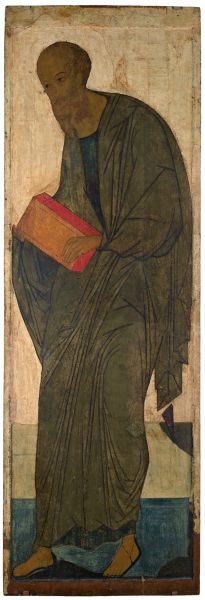|
|
St Paul. From Deisus Tier. Moscow. Circa 1408

Rublev Andrei,
Tempera on wood
311 x 104
State Russian Museum
Annotation
This work was painted by the leading master of Old Russian icons — Andrei Rublev. The graphia (contour scratched on the chalk priming), light-green underpainting with the pinkish ochre on the face and the image of the right foot survive best of all from the original early-fifteenth-century paintwork. The expressive silhouette, slow and repetitive rhythms and monumental forms convey the spiritual power of one of the leading apostles.
St Paul (originally Saul) was a Jew born in Tarsus. Although a Roman citizen in civil status, he was a member of the Pharisees sect. Saul was a vigorous persecutor of the disciples. Around the year 34 AD, he asked permission to go to Damascus to arrest all the Christians there. As he was approaching Damascus, he was surrounded by a bright light from heaven. As he fell to the ground, he heard a voice saying: “Saul, Saul! Why do you persecute me?” When Saul arose he found himself blind. After he recovered his sight, he was baptised and became one of the leading Christians. He wrote fourteen epistles now recognised by the church. Paul is believed to have been beheaded in Rome, around the year 64 AD.
Author's Biography
Rublev Andrei
Rublev, Andrei
Circa 1370 - Circa 1425
Leading Old Russian artist. Little authentic information on his biography exists. Lay brother of the St Sergius Monastery of the Trinity and then the Andronikov Monastery of the Saviour in Moscow. Helped Theophanes the Greek to paint the Cathedral of the Annunciation in the Moscow Kremlin (1405). Worked in Vladimir (1408). The famous Old Testament Trinity icon of the St Sergius Monastery of the Trinity is attributed to Rublev. Canonized by the Russian Orthodox Church (1988). Feast day 4/17 July.

